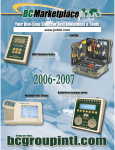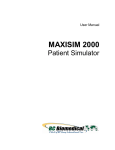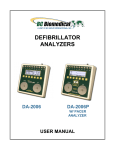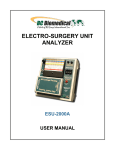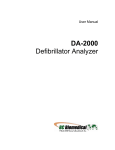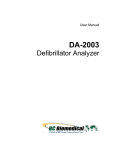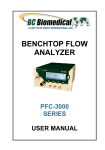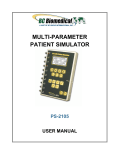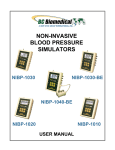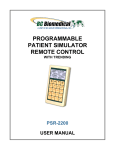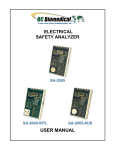Download ENDOCHECK™
Transcript
User Manual ENDOCHECK™ Test System CONTENTS I. II. III. IV. V. VI. VII. INTRODUCTION ............................................................... 2 SPECIFICATIONS ............................................................ 3 RECEIPT, INSPECTION & RETURN................................ 4 USE OF THE ENDOCHECK™ TEST SYSTEM ............... 5 APPLICATIONS................................................................ 6 WARRANTY ..................................................................... 7 TECHNICAL SUPPORT ................................................... 7 I. INTRODUCTION EndoCheck™ Features The EndoCheck™ Test System is a portable kit designed for qualitative and quantitative testing of light sources and fiber light cables used in a rigid endoscopy environment, and is intended to be used by trained service technicians. The kit does not check rigid endoscopes – only fiber cables & light sources. There are two primary parts to the kit: • The EndoProjector ™ is a precision optical component that yields an approximately 10X magnification of the light signal coming out of the fiber cable. The image, when displayed on a wall or other flat surface, generally allows the individual fibers to be observed, and thus make a qualitative inspection of the fiber cable. The EndoProjector ™ also provides for connection to a wide variety of fiber cables via its interchangeable connectors. • The 401025 light meter and light meter adapter, in conjunction with the EndoProjector ™, provide for quantitative analysis of both the light source and the fiber cable. The light meter reads in both lux and foot-candles. 2 II. SPECIFICATIONS BC Biomedical Model 401025 Light Meter Light level units & ranges Lux: 0-2,000, 0-20,000, & 0-50,000 Foot-Candles: 0-200, 0-2,000, & 0-5,000 Resolution .1 FC or 1 Lux Accuracy +/- 5% of full scale Detector Precision photo diode with color-correction filter; cosine/color corrected Analog output 1 mA per readout digit Dimensions 6.4” x 2.8” x 1.2” (163mmx7mm0x30mm); 9 oz. (220g) Power 9 volt battery (included) BC Biomedical EndoProjector™ Construction & Type Stainless steel body and precision glass optics Projection Magnification Approximately 10X Size 0.75” diameter x 1.375” long Light cable compatibility Adapters included to fit most popular endoscopy light cables BC Biomedical EndoCheck™ Light Meter Adapter Construction Plated steel Light cable compatibility Via EndoProjector™ Overall system Warranty on all 1 year from date of purchase Accessories Included • Hard carrying case • User manual This system does not include a light source or fiber cable. It is intended to be used with the customer’s light sources and fiber cables. 3 III. RECEIPT, INSPECTION & RETURN • Inspect the outer box for damage. • Carefully unpack all items and check to see that you have the following items: o EndoProjector™ o 401025 Light Meter o Light Meter adapter • If you note physical damage, or if the unit fails to function according to specification, inform the supplier immediately. When BC Group, or the company’s representative, is informed, measures will be taken to either repair the unit or dispatch a replacement. The customer should place a new purchase order to ensure delivery. • When returning an instrument to BC Group, make contact and request a Return Authorization (RA) number. When sending: fill out an address label, describe what is wrong with the instrument, and provide the model and serial numbers. If possible, use the original packaging material for return shipping. Otherwise, repack the unit using a reinforced cardboard box strong enough to carry the weight of the unit with an adequate amount of shock-absorbing material around the item(s.) • Repack the item(s) in a manner to ensure that they cannot shift in the box during shipment. • BC’s product warranty is listed elsewhere in this manual. The warranty does not cover freight charges. PRECAUTIONS • Avoid touching the lens of the EndoProjector™. Smudges and body oil will degrade the projected image quality. • The EndoProjector™ utilizes small parts that are easily lost or damaged. Exercise great care in the handling of these fragile pieces. • Do not exceed the maximum range of the light meter as damage to the light sensor can occur. The maximum allowable light input is 50,000 lux or 5,000 foot-candles. 4 IV. USE OF THE ENDOCHECK™ TEST SYSTEM Qualitative Analysis of Fiber Light Cables with the EndoProjector ™ 1. Turn the light source off. 2. Connect the fiber light cable to be inspected to the light source. Connect the other end to the EndoProjector ™. Note that the EndoProjector™ has two (2) removable/screw-on adapters. Depending on the type and brand of fiber cable being connected, both adapters may stay in place, or one or both may need to be removed. Most common fiber cables found in a rigid endoscopy environment can be connected using one of the adapters supplied. 3. Turn the light intensity output control on the light source to the minimum level, and turn on the light source. Shine the output of the EndoProjector™ onto a flat surface like a wall. It may be helpful to dim the ambient light level in the room for optimum viewing of the projected image. 4. Adjust the light intensity from the light source as desired. 5. While holding the fiber cable near the EndoProjector™, carefully slide the outside body of the EndoProjector™ in or out to yield a sharply-focused image. When optimal focus is achieved, the individual fibers of the fiber bundle will be visible. The distance from the surface onto which the projected image is viewed, the position of the sliding outside body of EndoProjector™, and the intensity of the light all play a role in focus and image quality. After a bit of trial and error, the user will quickly become skilled at achieving optimal image quality and focus. Caution: The sliding outside body can come completely off the EndoProjector™. Even though it is easily put back in place, care should be exercised to avoid removing the body. 6. While observing the sharply-focused and optimally-sized image, an assessment may be made as to the relative quality of the fiber cable. For instance, if approximately 50% of the fibers in the bundle are broken, this will be readily apparent. The purpose of EndoProjector™ is not to allow counting of individual fibers or to make a quantitative assessment of cable quality. It allows a quick, visual, and intuitive analysis of relative cable quality. 7. If a quantitative analysis of the light source and cable using the light meter is desired, leave the EndoProjector™ on the fiber cable and turn the light source intensity down. Otherwise, if the inspection is complete, turn off the light source and disconnect all equipment. Quantitative Analysis of Fiber Light Cable and Light Source with the Light Meter 1. Turn the light source off. 2. Connect the fiber light cable to be inspected to the light source. Connect the other end to the EndoProjector ™. Note that the EndoProjector™ has two (2) removable/screw-on adapters. Depending on the type and brand of fiber cable being connected, both adapters may stay in place, or one or both may need to be removed. Most common fiber cables found in a rigid endoscopy environment can be connected using one of the adapters supplied. 3. Turn on the light meter and select the highest range (50,000 lux.) Place the light meter’s sensor on a flat, stable, horizontal surface, and install the light meter adapter onto it. Insert the EndoProjector™ into the small opening on the top of the light meter adapter. 4. Turn the light intensity output control on the light source to the minimum level, and turn on the light source. 5. Read the light intensity on the light meter. Various settings on the light source may require changing ranges on the light meter. Do not exceed the maximum range of the light meter as damage to the light sensor can occur. The maximum allowable light input is 50,000 lux or 5,000 foot-candles. Note that readings on the 50,000 lux range must be multiplied by 100. A reading of “500” on this range equals 500 x 100 = 50,000 lux. Never allow the light meter reading to exceed “500” on the 50,000 lux scale. 6. This system may be used to compare known good components with suspected bad components, and to establish benchmarks. See the “Applications” section for more information on suggested uses. 7. Turn the light source and light meter off, and disconnect all equipment. 5 V. APPLICATIONS The EndoCheck™ Test System is a versatile product. Several suggested applications and methods for using it follow. Suspected bad fiber cables Connect a known-good or new fiber cable of the same type as the suspect one, and take a reading with the light meter. Keeping the light source at the same setting, connect the suspect fiber cable and compare its reading to the good one. Suspected bad light source or lamp Connect a known-good or new fiber cable to a known-good light source, and take a reading with the light meter. Keeping the same fiber cable, replace with good light source with the suspect source and, at the same intensity setting, compare its reading to the good one. Fiber Cable Inspections as part of routine Preventive Maintenance (PM) Procedures Use EndoProjector™ to perform a visual inspection of fiber cables during each PM inspection. Record the technician’s assessment of relative amount of fibers that provide light throughput. Benchmarking Fiber Cables For each type or brand of fiber cables used in a facility, document the light meter’s reading for a new cable. For best consistency, always use the same light source at the same setting for all subsequent tests. Set a lower limit of light throughput based on this initial new-cable benchmark. For instance, if a new “Brand X” fiber cable reads 10,000 lux when connected to a specific light source at a predetermined intensity setting, you may choose to replace those fiber cables whenever they degrade to 80% of new light throughput, or 8,000 lux. (Note: These lux readings and percentage amounts are for illustration only, and are not recommendations. Each facility is encouraged to establish their own benchmarks based on their own unique situations and equipment.) Benchmarking Light Sources For each type or brand of light source or replacement light source lamp used in a facility, document the light meter’s reading for a new one. For best consistency, always use the same fiber cable and the same light source intensity setting for all subsequent tests. Set a lower limit of light output based on this initial new-source or new-lamp benchmark. For instance, if a new “Brand X” light source lamp reads 10,000 lux at a predetermined intensity setting, you may choose to replace those lamps whenever they degrade to 80% of new light output, or 8,000 lux. (Note: These lux readings and percentage amounts are for illustration only, and are not recommendations. Each facility is encouraged to establish their own benchmarks based on their own unique situations and equipment.) Other Uses for the Light Meter The light meter may be used for a variety of applications in the healthcare setting, including: • X-Ray collimator light testing • Surgery light testing • General workplace lighting analysis • Measurement of visible light for any purpose Do not exceed the sensor’s maximum capacity. See the warning elsewhere in this manual. 6 VI. WARRANTY BC Biomedical warrants that the EndoCheck™ Test System will substantially conform to published specifications and to the documentation, provided that it is used for the purpose for which it was designed. BC Biomedical will, for a period of twelve (12) months from date of purchase, replace or repair any defective test system, if the fault is due to a manufacturing defect. In no event will BC Biomedical or its local representatives be liable for direct, indirect, special, incidental, or consequential damages arising out of the use of or inability to use the EndoCheck™ Test System, even if advised of the possibility of such damages. BC Biomedical or its local representatives are not responsible for any costs, loss of profits, loss of data, or claims by third parties due to use of, or inability to use the EndoCheck™ Test System. Neither BC Biomedical nor its local representatives will accept, nor be bound by any other form of guarantee concerning the EndoCheck™ Test System other than this guarantee. Some jurisdictions do not allow disclaimers of expressed or implied warranties in certain transactions; therefore, this statement may not apply to you. VII. TECHNICAL SUPPORT BC Biomedical’s EndoCheck™ Test System is backed by a superior support staff. EndoCheck™ ever fails to work perfectly, please contact the Technical Support Staff. If the Written Communications You may write a letter with your comments and send it to: BC Biomedical BC Group International, Inc. 3081 Elm Point Industrial Dr St. Charles, MO USA 63301 OR E-mail: [email protected] Phone Support You can telephone the Technical Assistance Center at 314-638-3800 or 1-800-242-8428 between 8:00 AM and 4:30 PM Central Standard Time (CST) Monday through Friday, except holidays. Whichever method of contact you choose, please provide the following information: • Product name and serial number • Revision level of your software • The specific steps which reproduce your problem • Any error codes • A daytime phone number, fax number, and/or email address (if available) • Your name / company 7








